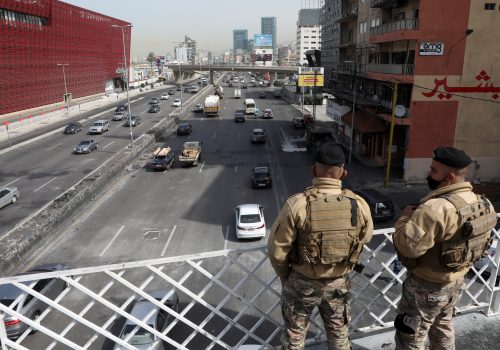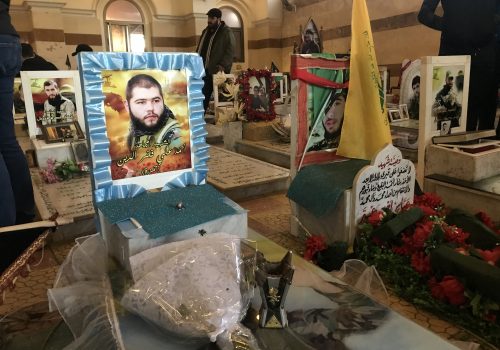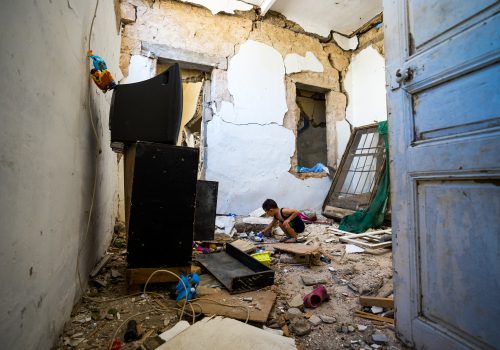Rockets were fired from Lebanon into Israel again. Another game of brinkmanship?
While Lebanon descends into ever greater political, economic, and social turmoil, a new dynamic appears to be emerging along Lebanon’s simmering southern border with Israel. It potentially threatens the balance of deterrence that has helped prevent a major escalation of hostilities for fifteen years.
In the past three weeks, rockets have been launched from south Lebanon on three occasions into Israel or Israeli-occupied territory. On August 6, at least twenty rockets were launched towards the Shebaa Farms, a mountainside seized from Syria by Israel in 1967 but claimed by Beirut as Lebanese territory. Iran-backed militant group Hezbollah claimed responsibility for the barrage, saying it was a response to Israeli airstrikes in south Lebanon a day earlier. Those airstrikes were part of a retaliation to the unclaimed firing of three rockets toward Israel on August 4.
Both Israel and Hezbollah have publicly declared that they do not seek an escalation. Nevertheless, this latest game of brinkmanship underlines the enduring frailties of the balance of deterrence and the potential for miscalculation.
Since the July-August 2006 war between Israel and Hezbollah, there have been approximately twenty-two episodes of cross-border rocket fire from south Lebanon into Israel, including the August 6 attack. Almost all coincided with Israel’s periodic military campaigns against militant group Hamas in the Gaza Strip. The unclaimed attacks were amateurish in nature; rockets were fired from crude launchers made of planks of wood and caused no casualties. Often, the rockets fell short of the border, crashed into the sea, or failed to launch at all. The source of fire was generally confined to the coastal littoral of south Lebanon around the Shia-populated village of Qlayle, south of Tyre—an area thick with banana groves and orange orchards.
The conventional wisdom is that these rockets were launched by unnamed “rogue” Palestinian groups operating in Lebanon, based mainly on the linkage to Israeli campaigns in Gaza, their seemingly amateurish nature, and the presence of three refugee camps in the Tyre district from where the perpetrators could potentially emerge. While Palestinian groups may have been responsible for some attacks, the most plausible culprit for the bulk of them, if not all, is Hezbollah. The group adopts a crude operational style by design to disguise its fingerprints and to greatly reduce the risk of causing the kind of casualties or damage in Israel that could trigger an escalation that the party does not seek.
The village of Qlayle, the source of most rocket attacks, is a well-known center of support for Hezbollah and was a regular launchpad for rocket fire during the Israeli occupation of south Lebanon before 2000. It strains the bounds of credulity to believe that Palestinians have been able to enter this area repeatedly and independently since 2006 to fire rockets at Israel and could escape without being apprehended by Hezbollah or the Lebanese Armed Forces. Furthermore, even if a Palestinian faction carried out an attack, it is unlikely that it would have been conducted without Hezbollah’s nod of approval. Hezbollah jealously guards its monopoly of violence along the Blue Line—the United Nations’ name for Lebanon’s southern boundary. The rules of the game between Hezbollah and Israel along the Blue Line have been finely tuned over many years. Hezbollah would not want rogue actors potentially disrupting that balance through uncoordinated operations that could provoke an unwanted escalation.
In May, Israel’s Operation Guardian of the Walls saw a reprisal of rocket fire from Lebanon with three separate attacks. The first, again emanated from orchards close to Qlayle and all three rockets fell into the sea. According to a source with the United Nations Interim Force in Lebanon (UNIFIL), a peacekeeping force in southern Lebanon, in the immediate aftermath of the launch, a patrol went to investigate and stumbled across a pick-up truck full of armed men who told the blue helmets to leave the area immediately. The six rockets fired in the second attack all landed in Lebanon. The third attack involved the launch of four rockets, one of which landed a few miles east of Haifa in northern Israel. The source of rocket fire was in or very close to a valley lying between the Hezbollah-supporting villages of Jabal Botm and Siddiqine in south Lebanon. Hezbollah routinely used the valley in the 1990s as a source of mortar and rocket fire against Israeli positions to the south.
Veterans of the Israeli air force would be familiar with the valley as it was regularly bombed in the wake of Hezbollah mortar attacks in what UNIFIL used to derisively describe as “rock-crushing exercises.” Israeli officials publicly pinned all three attacks in May on unnamed Palestinian groups, but any Israeli army officer with a long memory will surely have recognized that the third attack carried with it a whiff of Hezbollah. By the same token, Hezbollah almost certainly used the valley between Siddiqine and Jabal Botm, along with the use of extended-range rockets, to subtly signal to the Israelis who was really responsible.
The incidents of rocket fire ended with the culmination of the Guardian of the Walls operation. But, on July 20, two rockets were fired from near Qlayle into Israel. Israeli officials linked the unclaimed attack to Lebanon’s economic crisis. On August 4, another three rockets were launched at Israel; two landed near Kiryat Shemona in northern Galilee. The source of fire was from near the hamlet of Mahmoudiyeh and the edge of a sealed-off Hezbollah military zone just north of the Litani river. Israel immediately responded with customary artillery fire, but followed up with separate airstrikes south of Tyre and near Mahmoudiyeh then in the early hours of August 5. It was the first air raid by Israel into Lebanese territory since February 2014 and the first to hit south Lebanon since the 2006 war.
By now, a new round of brinkmanship between Israel and Hezbollah was well underway. Both sides have been down this road before, but not since before 2006. In 2001, Israel staged airstrikes against Syrian military positions in Lebanon to press Damascus to halt Hezbollah’s attacks in the Shebaa Farms. After a second Syrian position in the Bekaa Valley was destroyed, Hezbollah immediately retaliated with an unprecedentedly heavy mortar barrage against an Israeli compound in the Shebaa Farms. The Israeli air attacks against Syrian positions ended. The following year, Hezbollah began firing anti-aircraft rounds across the border as a response to Israeli breaches of Lebanese airspace. The rounds exploded in the air, peppering whatever lay below with shrapnel. After an Israeli teenager was killed by this, the Israelis began striking Hezbollah’s anti-aircraft guns every time they were fired. Hezbollah quickly abandoned the tactic.
On August 6, around twenty rockets were launched into the Shebaa Farms. Some were shot down by the Iron Dome system and others exploded in empty areas. Hezbollah claimed responsibility, saying that they “bombed open areas in the vicinity of Israeli occupation positions in the Shebaa Farms” in a statement.
The unusual Israeli air raids had compelled Hezbollah to react—to restore the balance of deterrence. However, Hezbollah was careful to set a de-escalatory tone by noting that, as the airstrikes had hit unpopulated areas, so too had Hezbollah’s rockets.
Nevertheless, it remains unclear what motivated the July 20 and August 4 attacks. Assuming Hezbollah was the perpetrator, which seems likely, there are numerous potential—albeit probably weak—motives, both domestic and regional. The July 20 rocket attack came a day after an Israeli strike near Aleppo in northern Syria, in which Iranian and Hezbollah operatives are believed to have died. Other potential motives could be to test the resolve of Israel’s new prime minister, Naftali Bennet, who took office in June. Or it could connected to the “shadow maritime war” between Iran and Israel in the waters of the Gulf or the Iran nuclear talks in Vienna. It could even be an attempt to deflect attention from Lebanon’s deepening economic crisis. The August 4 rocket attack came the same day that Lebanon commemorated the first anniversary of the devastating explosion at Beirut port which heavily damaged a broad swathe of east Beirut and left more than two hundred people dead.
In an intriguing postscript to Hezbollah’s August 6 rocket barrage, the vehicle that carried out the strike was intercepted by furious Druze residents of the village of Shwaya as it headed north. The unarmed Hezbollah men—they were engineers whose job is limited to aiming and firing the rockets—were beaten and accused of endangering the lives of the residents by firing rockets near their village. The Lebanese army intervened and arrested the Hezbollah men and confiscated the truck, but later released them. Cellphone footage of the incident went viral on social media.
For now, the balance of deterrence between Israel and Hezbollah appears to be holding. The prospect of full-scale war remains a powerful disincentive for either side to push too far. The question is whether there will be any further anonymous “Palestinian-style” rocket attacks into Israel—and how the Israelis will respond—or whether the July 20 and August 4 incidents were anomalies. Nevertheless, the aftermath of the August 6 game of brinkmanship between Israel and Hezbollah has visibly underlined that there is no appetite in Lebanon for renewed hostilities with Israel. That includes Hezbollah’s Shia support base, which is struggling daily alongside everyone else to find food, fuel, and medicine for their families and to cope with the economic and social disaster that has befallen Lebanon.
Nicholas Blanford is a nonresident senior fellow with the Middle East Security Initiative at the Atlantic Council’s Scowcroft Center for Strategy and Security.
Image: A Lebanese army member walks near a pickup truck with a rocket launcher in Chouaya, Lebanon, August 6, 2021. REUTERS/Karamallah Daher


